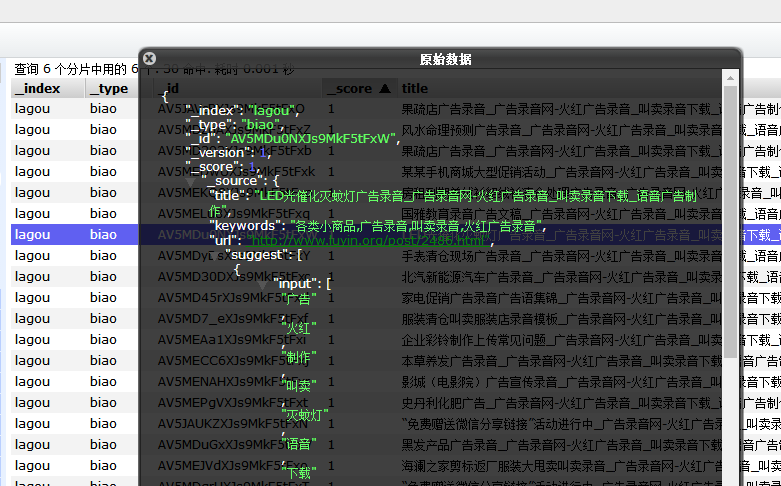第三百六十八节,Python分布式爬虫打造搜索引擎Scrapy精讲—用Django实现搜索的自动补全功能

elasticsearch(搜索引擎)提供了自动补全接口
官方说明:https://www.elastic.co/guide/en/elasticsearch/reference/current/search-suggesters-completion.html
1、创建搜索自动补全字段suggest
自动补全需要用到一个字段名称为suggest类型为Completion类型的一个字段
所以我们需要用将前面的elasticsearch-dsl操作elasticsearch(搜索引擎)增加suggest类型为Completion
注意:因为elasticsearch-dsl源码问题,设置字段为Completion类型指定分词器时会报错,所以我们需要重写CustomAnalyzer类
只有Completion类型才是,其他类型不用,其他类型直接指定分词器即可
#!/usr/bin/env pythonfrom datetime import datetimefrom elasticsearch_dsl import DocType, Date, Nested, Boolean, \ analyzer, InnerObjectWrapper, Completion, Keyword, Text, Integer# 更多字段类型见第三百六十四节elasticsearch(搜索引擎)的mapping映射管理from elasticsearch_dsl.analysis import CustomAnalyzer as _CustomAnalyzer #导入CustomAnalyzer类from elasticsearch_dsl.connections import connections # 导入连接elasticsearch(搜索引擎)服务器方法connections.create_connection(hosts=['127.0.0.1'])class CustomAnalyzer(_CustomAnalyzer): # 自定义CustomAnalyzer类,来重写CustomAnalyzer类 def get_analysis_definition(self): return {}ik_analyzer = CustomAnalyzer("ik_max_word", filter=["lowercase"]) # 实例化重写的CustomAnalyzer类传入分词器和大小写转,将大写转换成小写class lagouType(DocType): # 自定义一个类来继承DocType类 suggest = Completion(analyzer=ik_analyzer) # Text类型需要分词,所以需要知道中文分词器,ik_max_wordwei为中文分词器 title = Text(analyzer="ik_max_word") # 设置,字段名称=字段类型,Text为字符串类型并且可以分词建立倒排索引 description = Text(analyzer="ik_max_word") keywords = Text(analyzer="ik_max_word") url = Keyword() # 设置,字段名称=字段类型,Keyword为普通字符串类型,不分词 riqi = Date() # 设置,字段名称=字段类型,Date日期类型 class Meta: # Meta是固定写法 index = "lagou" # 设置索引名称(相当于数据库名称) doc_type = 'biao' # 设置表名称if __name__ == "__main__": # 判断在本代码文件执行才执行里面的方法,其他页面调用的则不执行里面的方法 lagouType.init() # 生成elasticsearch(搜索引擎)的索引,表,字段等信息# 使用方法说明:# 在要要操作elasticsearch(搜索引擎)的页面,导入此模块# lagou = lagouType() #实例化类# lagou.title = '值' #要写入字段=值# lagou.description = '值'# lagou.keywords = '值'# lagou.url = '值'# lagou.riqi = '值'# lagou.save() #将数据写入elasticsearch(搜索引擎)
2、搜索自动补全字段suggest写入数据
搜索自动补全字段suggest接收的要搜索的字段分词数据,详情见下面的自定义分词函数
elasticsearch-dsl操作elasticsearch(搜索引擎)
#!/usr/bin/env python# -*- coding:utf8 -*-#!/usr/bin/env pythonfrom datetime import datetimefrom elasticsearch_dsl import DocType, Date, Nested, Boolean, \ analyzer, InnerObjectWrapper, Completion, Keyword, Text, Integerfrom elasticsearch_dsl.connections import connections # 导入连接elasticsearch(搜索引擎)服务器方法# 更多字段类型见第三百六十四节elasticsearch(搜索引擎)的mapping映射管理from elasticsearch_dsl.analysis import CustomAnalyzer as _CustomAnalyzer #导入CustomAnalyzer类connections.create_connection(hosts=['127.0.0.1'])class CustomAnalyzer(_CustomAnalyzer): # 自定义CustomAnalyzer类,来重写CustomAnalyzer类 def get_analysis_definition(self): return {}ik_analyzer = CustomAnalyzer("ik_max_word", filter=["lowercase"]) # 实例化重写的CustomAnalyzer类传入分词器和大小写转,将大写转换成小写class lagouType(DocType): # 自定义一个类来继承DocType类 suggest = Completion(analyzer=ik_analyzer) # Text类型需要分词,所以需要知道中文分词器,ik_max_wordwei为中文分词器 title = Text(analyzer="ik_max_word") # 设置,字段名称=字段类型,Text为字符串类型并且可以分词建立倒排索引 description = Text(analyzer="ik_max_word") keywords = Text(analyzer="ik_max_word") url = Keyword() # 设置,字段名称=字段类型,Keyword为普通字符串类型,不分词 riqi = Date() # 设置,字段名称=字段类型,Date日期类型 class Meta: # Meta是固定写法 index = "lagou" # 设置索引名称(相当于数据库名称) doc_type = 'biao' # 设置表名称def gen_suggest(index, info_tuple): # 根据字符串生成搜索建议数组 """ 此函数主要用于,连接elasticsearch(搜索引擎),使用ik_max_word分词器,将传入的字符串进行分词,返回分词后的结果 此函数需要两个参数: 第一个参数:要调用elasticsearch(搜索引擎)分词的索引index,一般是(索引操作类._doc_type.index) 第二个参数:是一个元组,元祖的元素也是元组,元素元祖里有两个值一个是要分词的字符串,第二个是分词的权重,多个分词传多个元祖如下 书写格式: gen_suggest(lagouType._doc_type.index, (('字符串', 10),('字符串', 8))) """ es = connections.create_connection(lagouType._doc_type.using) # 连接elasticsearch(搜索引擎),使用操作搜索引擎的类下面的_doc_type.using连接 used_words = set() suggests = [] for text, weight in info_tuple: if text: # 调用es的analyze接口分析字符串, words = es.indices.analyze(index=index, analyzer="ik_max_word", params={ 'filter':["lowercase"]}, body=text) anylyzed_words = set([r["token"] for r in words["tokens"] if len(r["token"])>1]) new_words = anylyzed_words - used_words else: new_words = set() if new_words: suggests.append({ "input":list(new_words), "weight":weight}) # 返回分词后的列表,里面是字典, # 如:[{'input': ['录音', '广告'], 'weight': 10}, {'input': ['新能源', '汽车',], 'weight': 8}] return suggestsif __name__ == "__main__": # 判断在本代码文件执行才执行里面的方法,其他页面调用的则不执行里面的方法 lagouType.init() # 生成elasticsearch(搜索引擎)的索引,表,字段等信息# 使用方法说明:# 在要要操作elasticsearch(搜索引擎)的页面,导入此模块# lagou = lagouType() #实例化类# lagou.title = '值' #要写入字段=值# lagou.description = '值'# lagou.keywords = '值'# lagou.url = '值'# lagou.riqi = '值'# lagou.save() #将数据写入elasticsearch(搜索引擎)
suggest字段写入数据
# -*- coding: utf-8 -*-# Define here the models for your scraped items## See documentation in:# http://doc.scrapy.org/en/latest/topics/items.html# items.py,文件是专门用于,接收爬虫获取到的数据信息的,就相当于是容器文件import scrapyfrom scrapy.loader.processors import MapCompose, TakeFirstfrom scrapy.loader import ItemLoader # 导入ItemLoader类也就加载items容器类填充数据from adc.models.elasticsearch_orm import lagouType, gen_suggest # 导入elasticsearch操作模块class LagouItemLoader(ItemLoader): # 自定义Loader继承ItemLoader类,在爬虫页面调用这个类填充数据到Item类 default_output_processor = TakeFirst() # 默认利用ItemLoader类,加载items容器类填充数据,是列表类型,可以通过TakeFirst()方法,获取到列表里的内容def tianjia(value): # 自定义数据预处理函数 return value # 将处理后的数据返给Itemclass LagouItem(scrapy.Item): # 设置爬虫获取到的信息容器类 title = scrapy.Field( # 接收爬虫获取到的title信息 input_processor=MapCompose(tianjia), # 将数据预处理函数名称传入MapCompose方法里处理,数据预处理函数的形式参数value会自动接收字段title ) description = scrapy.Field() keywords = scrapy.Field() url = scrapy.Field() riqi = scrapy.Field() def save_to_es(self): lagou = lagouType() # 实例化elasticsearch(搜索引擎对象) lagou.title = self['title'] # 字段名称=值 lagou.description = self['description'] lagou.keywords = self['keywords'] lagou.url = self['url'] lagou.riqi = self['riqi'] # 将title和keywords数据传入分词函数,进行分词组合后返回写入搜索建议字段suggest lagou.suggest = gen_suggest(lagouType._doc_type.index, ((lagou.title, 10),(lagou.keywords, 8))) lagou.save() # 将数据写入elasticsearch(搜索引擎对象) return
写入elasticsearch(搜索引擎)后的情况
{ "_index": "lagou", "_type": "biao", "_id": "AV5MDu0NXJs9MkF5tFxW", "_version": 1, "_score": 1, "_source": { "title": "LED光催化灭蚊灯广告录音_广告录音网-火红广告录音_叫卖录音下载_语音广告制作", "keywords": "各类小商品,广告录音,叫卖录音,火红广告录音", "url": "http://www.luyin.org/post/2486.html", "suggest": [ { "input": [ "广告" , "火红" , "制作" , "叫卖" , "灭蚊灯" , "语音" , "下载" , "led" , "录音" , "灭蚊" , "光催化" , "催化" ], "weight": 10 } , { "input": [ "小商品" , "广告" , "各类" , "火红" , "叫卖" , "商品" , "小商" , "录音" ], "weight": 8 } ], "riqi": "2017-09-04T16:43:20", "description": "LED光催化灭蚊灯广告录音 是广告录音网-火红广告录音中一篇关于 各类小商品 的文章,欢迎您阅读和评论,专业叫卖录音-广告录音-语音广告制作" }} 
用Django实现搜索的自动补全功能说明
1.将搜索框绑定一个事件,每输入一个字触发这个事件,获取到输入框里的内容,用ajax将输入的词请求到Django的逻辑处理函数。
2.在逻辑处理函数里,将请求词用elasticsearch(搜索引擎)的fuzzy模糊查询,查询suggest字段里存在请求词的数据,将查询到的数据添加到自动补全
html代码:
{#引入静态文件路径#}{% load staticfiles %} lcv-search 搜索引擎
Django路由映射
"""pachong URL ConfigurationThe `urlpatterns` list routes URLs to views. For more information please see: https://docs.djangoproject.com/en/1.10/topics/http/urls/Examples:Function views 1. Add an import: from my_app import views 2. Add a URL to urlpatterns: url(r'^$', views.home, name='home')Class-based views 1. Add an import: from other_app.views import Home 2. Add a URL to urlpatterns: url(r'^$', Home.as_view(), name='home')Including another URLconf 1. Import the include() function: from django.conf.urls import url, include 2. Add a URL to urlpatterns: url(r'^blog/', include('blog.urls'))"""from django.conf.urls import urlfrom django.contrib import adminfrom app1 import viewsurlpatterns = [ url(r'^admin/', admin.site.urls), url(r'^$', views.indexluoji), url(r'^index/', views.indexluoji), url(r'^suggest/$', views.suggestluoji,name="suggest"), # 搜索字段补全请求]
Django静态文件配置
# Static files (CSS, JavaScript, Images)# https://docs.djangoproject.com/en/1.10/howto/static-files/#配置静态文件前缀STATIC_URL = '/static/'#配置静态文件目录STATICFILES_DIRS = [ os.path.join(BASE_DIR, 'static')]
备注:搜索自动补全fuzzy查询
#搜索自动补全fuzzy查询POST lagou/biao/_search?pretty{ "suggest":{ #字段名称 "my_suggest":{ #自定义变量 "text":"广告", #搜索词 "completion":{ "field":"suggest", #搜索字段 "fuzzy":{ "fuzziness":1 #编辑距离 } } } }, "_source":"title"} Django逻辑处理文件
from django.shortcuts import render# Create your views here.from django.shortcuts import render,HttpResponsefrom django.views.generic.base import Viewfrom app1.models import lagouType #导入操作elasticsearch(搜索引擎)类import jsondef indexluoji(request): print(request.method) # 获取用户请求的路径 return render(request, 'index.html')def suggestluoji(request): # 搜索自动补全逻辑处理 key_words = request.GET.get('s', '') # 获取到请求词 re_datas = [] if key_words: s = lagouType.search() # 实例化elasticsearch(搜索引擎)类的search查询 s = s.suggest('my_suggest', key_words, completion={ "field": "suggest", "fuzzy": { "fuzziness": 2 }, "size": 5 }) suggestions = s.execute_suggest() for match in suggestions.my_suggest[0].options: source = match._source re_datas.append(source["title"]) return HttpResponse(json.dumps(re_datas), content_type="application/json")

最终完成
